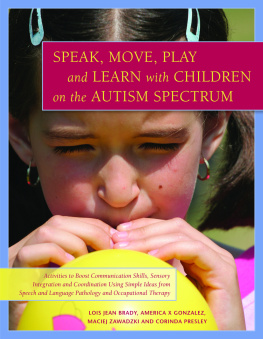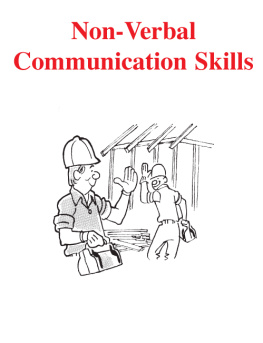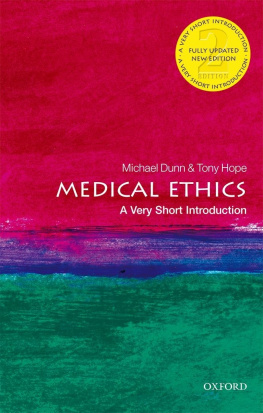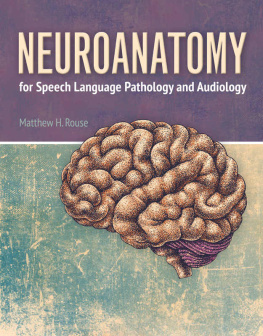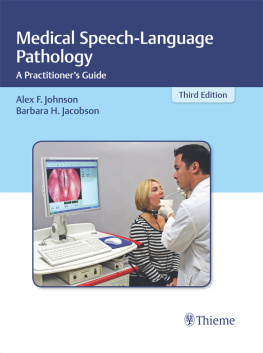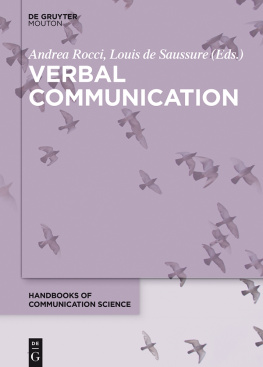Professional Communication in Speech-Language Pathology
How to Write, Talk, and Act Like a Clinician
Fourth Edition
Professional Communication in Speech-Language Pathology
How to Write, Talk, and Act Like a Clinician
Fourth Edition
A. Embry Burrus, MCD, CCC-SLP
Laura B. Willis, MCD, CCC-SLP


5521 Ruffin Road
San Diego, CA 92123
e-mail:
Website: https://www.pluralpublishing.com
Copyright 2022 by Plural Publishing, Inc.
Typeset in 10-1/2/13 Garamond book by Achorn International
Printed in the United States of America by McNaughton & Gunn, Inc.
All rights, including that of translation, reserved. No part of this publication may be reproduced, stored in a retrieval system, or transmitted in any form or by any means, electronic, mechanical, recording, or otherwise, including photocopying, recording, taping, Web distribution, or information storage and retrieval systems without the prior written consent of the publisher.
For permission to use material from this text, contact us by
Telephone: (866) 758-7251
Fax: (888) 758-7255
e-mail:
Every attempt has been made to contact the copyright holders for material originally printed in another source. If any have been inadvertently overlooked, the publisher will gladly make the necessary arrangements at the first opportunity.
Disclaimer: Please note that ancillary content (such as documents, audio, and video, etc.) may not be included as published in the original print version of this book.
Library of Congress Cataloging-in-Publication Data:
Names: Burrus, A. Embry, author. | Willis, Laura B., author.
Title: Professional communication in speech-language pathology : how to write, talk, and act like a clinician / A. Embry Burrus, Laura B. Willis.
Description: Fourth edition. | San Diego, CA : Plural Publishing, Inc., [2022] | Includes bibliographical references and index.
Identifiers: LCCN 2020006680 | ISBN 9781635501681 (paperback) | ISBN 1635501687 (paperback)
Subjects: MESH: Speech-Language Pathologyeducation | Clinical Competence | Interpersonal Relations | Professional Practice
Classification: LCC RC423 | NLM WL 18 | DDC 616.85/5dc23
LC record available at https://lccn.loc.gov/2020006680
CONTENTS
Appendices
It was 8:14 on Monday morning and Abby strolled in for her 8:00 a.m. clinical practicum meeting with her supervisor Ms. Bryce. She lingered outside Ms. Bryces doorway, balancing a half-eaten breakfast sandwich and her cell phone while returning a text message. Ms. Bryce looked up and set aside the papers she had pulled out to work on while waiting for Abby. She waited for Abby to introduce herself, or at least explain herself, but Abby was focused on finishing her breakfast. Eventually, Ms. Bryce introduced herself and asked Abby, who was wearing a questionably short skirt and revealing tank top, to have a seat. Abby sat down across from Ms. Bryce and began to complain about how tired she was and that it was all her roommates fault that she was late. Ms. Bryce proceeded with the meeting, informing Abby about her expectations for the semester as well as vital information about Abbys client. Abby appeared to be listening to what Ms. Bryce said, but she did not take a single note. What Ms. Bryce could not tell from her interaction with Abby was that she was a compassionate and intelligent student who wanted, more than anything else, to help children with autism. It was obvious that Abby was unaware about the many facets of professionalism.
How could she become a successful speech-language pathologist who works in a community clinic, school system, or medical facility? If Abby did not get some instruction in professional appearance, professional demeanor, and professional communication before practicum started, her initial clinical experience would be similar to diving into a very cold pool of water. This textbook is designed to make the exciting journey from student to clinician more predictable and a bit less onerous for all students, especially those like Abby.
Preparing a student for the clinical practicum experience has always been a challenge. The students come to us eager about embarking on a new and rewarding profession. They have studied some of the disorders of communication in classes and observed treatment sessions performed either by master clinicians in the field or more advanced graduate students. When the time for clinical practicum arrives, they are enthusiastic and anxious about their first foray into a clinical relationship. Unfortunately, clinical work is one of those enterprises that almost all students enter with no practical experience. By our calculations, people in the speech-language pathology major have about three years to complete the transition from undergraduate student to competent clinical professional with a masters degree.
We asked ourselves many questions in planning this text: Would students have a better grasp of professionalism if examples were provided and it was more clearly delineated? Wouldnt it be nice if we could forewarn students about common pitfalls in the clinical practicum process so those pitfalls could be avoided? Would students operate more efficiently in off-campus placements if we spent a little time introducing the nature of those settings before the student leaves the university environment? Would clinical reports be of higher quality and written with more ease if we gave examples and provided suggestions for writing as well as a list of common errors? Would students be less anxious if we prepared them ahead of time with examples of the clinical documentation used in medical and school settings? Would students be better able to verbally interact with clients, families, other professionals, and supervisors if we provided suggestions regarding professional verbal communication? Clearly, we felt that the answers to our questions would no doubt be in the affirmative.
This textbook was designed to help speech-language pathology students as they approach and journey through the clinical practicum experience. There are several major characteristics that distinguish our textbook. First, we wanted to provide the student with a clear understanding of professional demeanor common to speech-language pathologists. It is our view that such professionalism is communicated through a variety of modalities. For instance, a persons behavior, written communications, and verbal communications are perceived by others as significant indices of professionalism. Actions can include such varied components as appearance, ethical behavior, decision making, planning clinical work, and nonverbal communication skills. Actions, as they say, often speak louder than words. Written communications range from various clinical reports to progress notes and e-mails. We project our level of professionalism every time we write any type of clinical documentation. Verbal communication with clients, families, other professionals, and supervisors is the means by which we provide information, obtain information, counsel, and solve problems related to clinical activity. Because the features of professional behavior, professional writing, and professional speaking are so important in defining a professional, we elected to name this textbook Professional Communication in Speech-Language Pathology: How to Write, Talk, and Act Like a Clinician. In this fourth edition of the text, we have revised, updated, and expanded upon the original text to include up-to-date research and current trends in clinical practicum.
Next page

